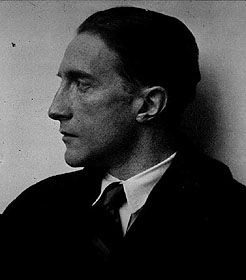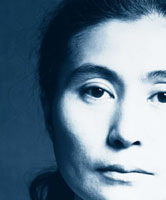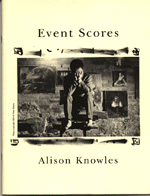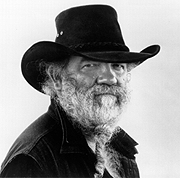| |
Verbal scores are basically instruction sets for a sound experience. They may be instructions for a person to perform physically, in order to generate a sound experience, or simply suggestions that work on a mental level. The best known examples from the past are the instruction pieces by Fluxus artists like Yoko Ono, but Duchamp also composed instruction pieces with sound output.
Examples from the past
by Marcel Duchamp
"Make a readymade with a box containing something unrecognizable by its sound and weld the box shut"
note from the Green Box
Some pieces by Yoko Ono
1. Piece from AOS
The theater or auditorium is without light.
It is announced that members of audience must find their own means of light for the ". . search. . ."
It is announced that a snake, butterfly, rabbit, grapefruit or a body, or anything the announcer thought he wished to see on the day of the production, has been released or hidden in the audience and the audience must find it.
Two performers who have been tightly bound together with rope then proceed from one side of the stage to the other and back as quickly as possible, trying not to make any audible sound.
The two performers must be tightly bound together, back to back, or front to front, or side to side, or with one performer upside down, or in any position in which they may be tightly bound together. Attached to their bonds must be tin cans, bottles or any objects that would make noise upon movement.
The title of the piece should be the name of the thing the announcer has decided to say has been released or hidden. Whatever it is, it should not actually be released or hidden, but only announced to that effect.
2. Bicycle Piece for Orchestra: Ride bicycles anywhere you can in the concert hall. Do not make any noise. (autumn 1962)
3. Laundry Piece: When you entertain guests, bring out your laundry and explain each item: how and when it became dirty and why, etc. (summer 1963)
4. Wall Piece I: Sleep two walls away from each other. Whisper to each other. (autumn 1963)
5. Beat Piece: Listen to a heart beat. (autumn 1963)
6. Laugh Piece: Keep laughing a week. (winter 1961)
7. Wall Piece for Orchestra: Hit a wall with your head. (winter 1962)
8. Collecting Piece: Collect sounds in your mind that you have heard throughout the week. Repeat them in your mind in a different order one afternoon. (autumn 1963)
by Fluxus artists:
Alison Knowles Proposition (1962): the performers are instructed to take the stage, make a salad, and leave.
Emmett Williams Voice Piece for La Monte Young (1963): the performer is instructed to ask whether La Monte Young is in the audience, and then to leave.
La Monte Young Composition #5 (1960): performers are instructed to "release a butterfly or any number of butterflies into the air".
VERBAL SCORES BY STUDENTS AT ACCADEMIA CARRARA, BERGAMO
from the course NOISE OF ART
Marco Poli
Mechanical Dream NEW!
Room no. 1.
Dim light smooths the corners.
Isolation in the five senses.
Slow mechanical stimuli flow,
tugging at the extremities of thoughts.
Closed door.
Entrance cathode corridor.
Closed window.
Glimpse of exit.
Room no. 2.
Next to no. 1.
Paintings of room no. 1 on the walls.
Take them down to hang them in room no. 3.
Leave room no. 2 in flames,
and the bonfires rise to the sky.
Sound Postcard from the Mountains
Rent a room in a hotel in a mountainous region of Italy during a slow season. Arrange to eat in the dining room, by yourself. Ask the hotel staff to turn on the television, to a news broadcast. (Such hotels often have televisions in the dining room.) Order spaghetti. Make sure to make lots of noise with your fork on the plate, and slurping sounds as you eat. Keep the volume of the news program quite loud.
Record the dinner and send it to your friends as a sound postcard.
Caterina Rossato
Madame Butterfly
1. Choose a person with whom to play the part: someone with whom you feel in tune. The more feminine of the two plays Madame Butterfly, the less feminine plays Pinkerton.
2. Learn your parts by heart with the proper pronunciation of the words from the opera libretto.
3. Listen endless numbers of times to a recording of the act you have chosen, learning the entrances by heart.
4. Watch a video of the opera starring Maria Callas and learn her movements, her positions, her expressions.
5. Try mouthing the part, lip-synching, in front of a mirror while listening to the recording.
6. When you feel ready, start rehearsing with your partner (who has also prepared in the same way, with great care). Rehearse in front of a large mirror.
7. Make sure your motions, lips, eyes, gestures are as perfect as possible. Now you are ready to live the opera.
8. Dress up in evening clothes, dark, preferably elegant, serious costumes. Relax and get into the part. Or dress up in operatic costumes, frilly, lacy, exaggerated. Relax and get into the part.
9. Mime the performance as the recording plays, inside a real theater or a similar place, in public, with an audience. Have someone shoot video.
Lucia Lauriola
Home Entertainment
When you are with friends, perhaps in a town where nothing ever happens, perhaps with no money to go elsewhere, you can make your own concert. Decide what sort of music you want to hear. Classical? Then do a concert for violins, pianoforte, horns, etc. Rock? Then do guitars, drums, bass. Each person chooses an instrument. If you have chosen violin, it is your job to say the word “violin”. The guitarist says the word “guitar”. And so on.
Prepare a score. You can write it on a piece of paper. Each line of text represents a beat. Decide when the guitar should come in or remain silent. Write the score like this:
1 guitar drums bass trumpet sax
2 guitar ----- bass ------- sax
3 ----- drums ---- ------- ---
4 ----- drums ---- ------- sax
and so on. Where there are dashes the performer remains silent.
On the first beat the five words are heard simultaneously. On the second only three instruments play. The third beat is drums only. The fourth is drums and sax.
You can also play with the onomatopoeic resemblance of instrument names and their sounds. This works very well in Italian. Veee-o-leee-no imitates the sound of a violin. Batteria conveys the idea of beating on drums. Cam-pan-a (bell) is like a swinging church bell, each syllable with a hard attack and a soft decay. Try this out in different languages.
You can also insert solos, repetitions and other types of rhythmic motifs. Someone has to beat time.
Ivan Perego
The Sounds of Habit
If you attend school or have a regular job you probably make the same trip back and forth between home and the school or workplace nearly every day. Next time you make the trip, write down all the sounds you hear. If it is a bus ride, organize the sound diary bus stop by bus stop. Note the weather conditions, the time, the number of miles or kilometers traveled. Write the sounds down as clearly as you can. Print the information on separate sheets of paper and hang them, in order, in a room, or in different spots in a building.
Ancilla Artusi and Luca Figliuoli
Shortwave Vocabulary
Take one or more old radios and play with the tuning dials. Find spots where only static or weird short wave noises are audible, or where snatches of music or speech with interference seem to hover somewhere out there on the airwaves.
Open a dictionary and find words you have never heard anyone use, not scientific technical terms or jargon, but perfectly good words that have simply fallen off the usage map. Say them out loud as you listen to the noise of the airwaves.
Steve
The Lyricist
Find an old manual typewriter that still works. Think of a song you know well. Imagine you are a songwriter/lyricist at work. You may be in a dingy office in New York with a view of an airshaft. Or on a sunny deck in Venice, California, with a view of the sea. You may be wearing an old overcoat and shivering because there is no heat, chain smoking, sandwich wrappers littering the desktop, ashtrays overflowing. Or you may be sipping a cool drink, wearing sunglasses and munching on potato chips. Describe the scene or even act it out, reconstruct it.
Now imagine you are writing the words to the song. Type them at your own pace, singing them only as quickly as you can get them down on paper. Sing to the pace of your typing.
Steve
Captions
Record a sound you find interesting. Record a number of different versions of the same sound, whatever it is. But always exactly the same sound, not a range of different similar sounds. In other words, if it is a car it should always be the same car. If it’s a bird, the same bird.
Now use whatever method you prefer to find a number of terms that refer to an emotional experience. You may select them in order, as they appear, from the pages of a novel. Happy, angry, melancholy, tired, disappointed, etc. Or more complex indications.
Associate the words with the sound in its different versions (ex. words on the screen in a video with soundtrack, earphones on the wall in a gallery with the words written next to them). Does the caption alter perception of the sound?
Research on instruction art can lead to a wider field... eventually trespassing into the admittedly legitimate realm of software as artform. Not quite ready for that? Then try this great missing link between the two: http://www.in-vacua.com/
|
 |






|





